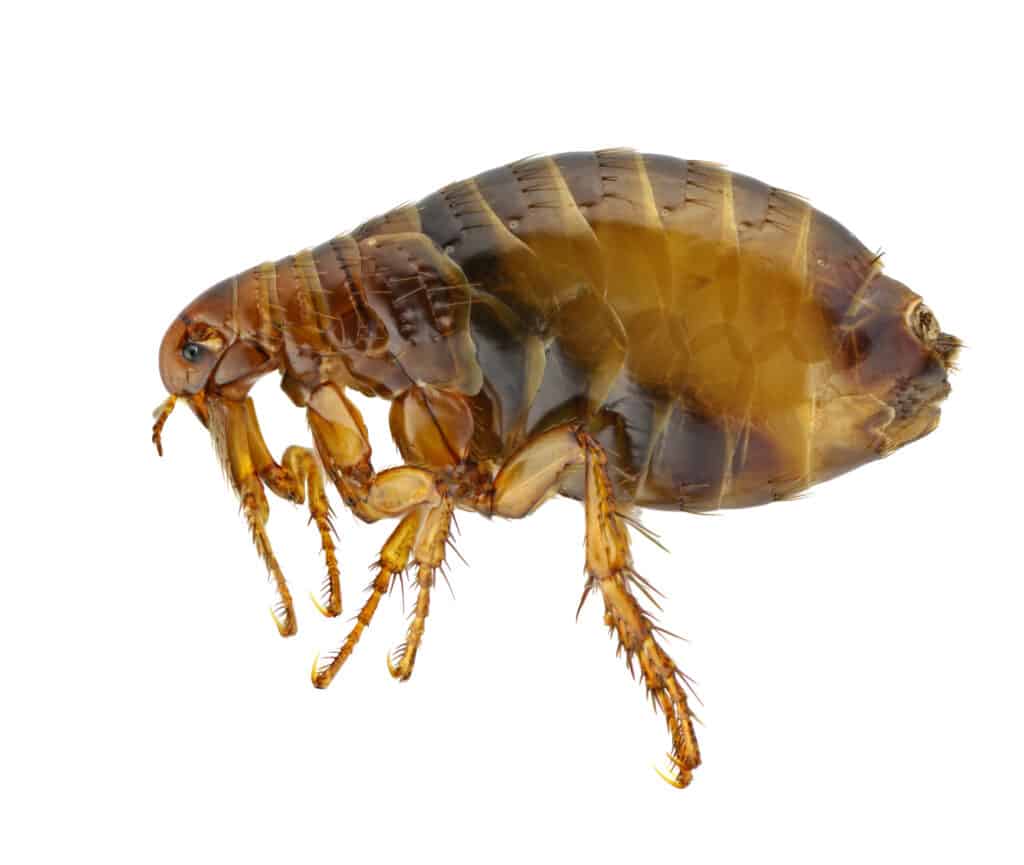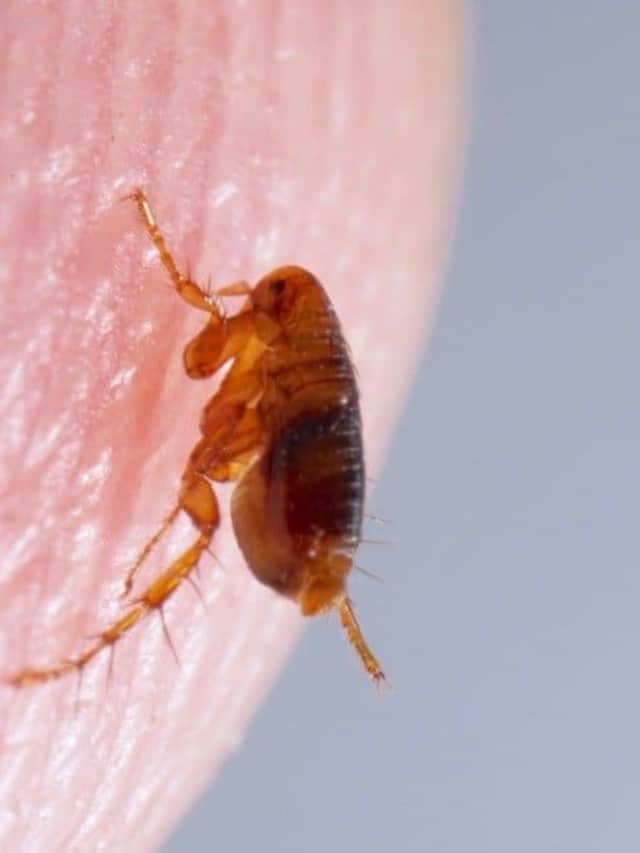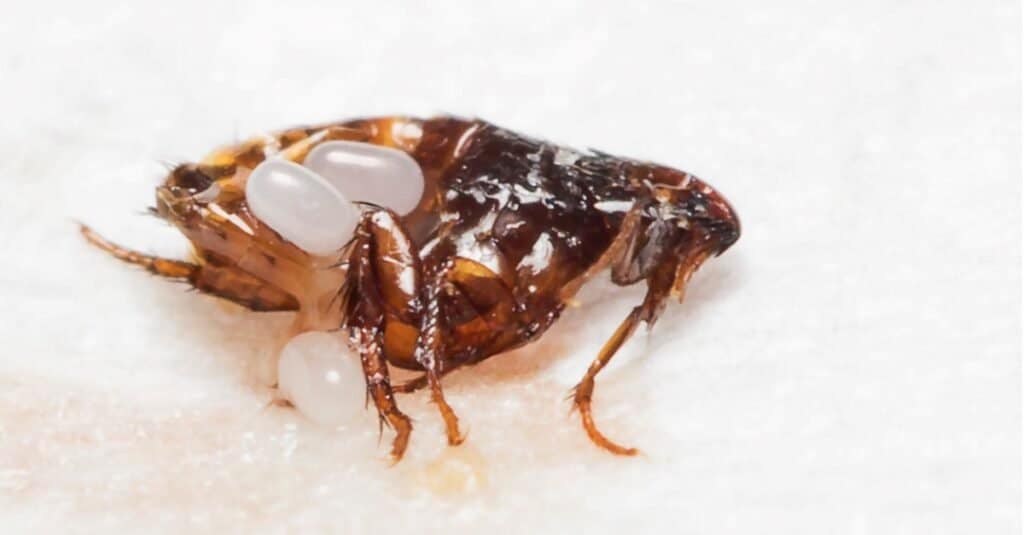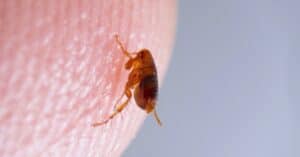As pet owners, we have all had to deal with the pesky problem of flea infestations. These tiny insects can cause a great deal of annoyance and discomfort for both our furry friends and ourselves. One of their most impressive abilities is their jumping prowess, which allows them to travel long distances and reach staggering heights relative to their size. But just how high (and far) can fleas jump? In this article, we will explore the physics behind flea jumps and reveal some fascinating facts about these incredible insects. So sit back, relax, and prepare to be amazed by the world of fleas!
Flea Overview

Fleas feed on the blood of mammals and birds.
©Cosmin Manci/Shutterstock.com
A flea is a small (one-eighth of one-inch) wingless insect that is known for its ability to jump long distances in a single leap. Fleas are one of the most proficient jumpers in the animal kingdom. There are 2,500 different species of fleas in the animal kingdom.
These tiny pests feed on the blood of mammals and birds and are often found on household pets such as dogs and cats. They have flattened bodies that allow them to move quickly through fur or feathers and also enable them to hide easily in cracks and crevices.
Fleas are not only a nuisance, but they can also transmit diseases such as tapeworms, typhus, and plague. Therefore it’s important for pet owners to take preventative measures against these pesky insects by regularly treating their furry companions with flea medication.
How High Can Fleas Jump?

Fleas are blood-eating parasites.
©Sahara Frost/Shutterstock.com
Fleas possess an incredible jumping ability, which enables them to jump vertically up to 8 inches and horizontally up to 13 inches! This remarkable feat is equivalent to 100 times their body length. If we were to compare this spectacular acrobatic display with humans, it would be like someone leaping a height of 250 feet and covering a distance of 450 feet horizontally! Such an astonishing leap capability is made possible by the strong hind legs of fleas, which are designed for explosive power and quick acceleration.
The impressive jumping prowess of fleas has been studied extensively by scientists who have found that these tiny creatures use their muscles in a unique way while jumping. They first compress their leg joints, then release the stored energy rapidly within just one millisecond, propelling themselves into the air at high speeds. Their amazing hopping ability allows them to easily move from one host animal to another or escape predators.
How Do Fleas Jump?
Fleas are known for their incredible jumping ability, which allows them to traverse impressive distances and heights. This remarkable talent is due in large part to the presence of a special elastic protein called resilin that is found within a pad on the flea’s legs. Resilin has the unique property of being able to store energy very efficiently, much like how a bowstring can store potential energy before it is released.
When fleas prepare to jump, they use their muscles to compress and deform the resilin pad, essentially “charging up” its stored energy. To prevent any accidental release of this energy before it’s needed, fleas have also evolved a sophisticated “catch mechanism,” which helps keep everything in place until just the right moment.
Once the flea decides it’s time to jump, one specific muscle contracts forcefully and pulls on a tendon located at the base of its leg. This action quickly extends both tibiae (the long bones in each leg) as well as their associated tarsi (or feet), causing an explosive release of energy from the compressed resilin pad.
Interestingly enough, high-speed video footage has revealed that contrary to popular belief, fleas actually take off from their tibiae and tarsi rather than from their knees! This newfound understanding provides even more insight into just how amazing these tiny insects really are. They are able of feats far beyond what we might expect, given their size and stature.
Flea Behavior and Adaptations

Fleas have adapted several interesting methods of remaining attached to their host.
©GoodFocused/Shutterstock.com
Fleas, though small and wingless, are incredibly well-adapted to their parasitic lifestyle. Their mouthparts have evolved to be long and sharp, allowing them to easily pierce the skin of their host and access a blood meal. In addition, their legs are equipped with powerful claws that allow them to cling tightly to fur or feathers as they move around on their host’s body.
One interesting feature of fleas is that they lack complex eyes like most insects do. Instead, they have simple eyespots or no eyes at all. This allows them to navigate through the dense hair or feather coverings of their hosts without being hindered by visual obstacles.
Another adaptation that helps fleas survive in their environment is the tough plates called sclerites that cover much of their bodies. These hard plates protect them from damage during attempts by hosts or predators to remove them.
Flea eggs are very small and white in color, shaped like ovals. The larvae that hatch from these eggs resemble tiny worms covered in bristles but lacking any visible eyesight capabilities. While adults feed exclusively on fresh blood for sustenance, flea larvae consume organic matter found in bedding materials or other debris within a home environment.
Despite being so small and seemingly vulnerable creatures compared to larger animals such as cats and dogs who commonly serve as hosts for fleas, these insects possess an impressive ability: They can withstand strong pressure applied when someone tries removing them forcefully from a host animal’s body with tweezers!
Flea Life Cycle

Fleas have the amazing ability to stay in their cocoon until conditions are optimal.
©iStock.com/FMT Fotografia
Fleas go through four life cycle states—egg, larva, pupa, and imago (which means adult). Some species of flea breed all year round, while others synchronize their activities with their hosts’ life cycle or environmental factors, such as weather.
Egg
Fleas are notorious for their exceptional jumping ability, but the number of eggs they lay is equally fascinating. The quantity of eggs laid by fleas depends on the species and can range from just two to several dozen in a single batch. However, the total number of eggs produced during a female flea’s lifetime varies significantly across species, ranging from approximately one hundred to several thousand.
Interestingly, different species have unique laying habits; some live within their host’s nest or burrow and deposit their eggs onto nearby surfaces. Other fleas prefer to lay their eggs directly on the host itself, and these can easily fall off onto surrounding grounds. This means that areas where hosts rest and sleep become primary habitats for developing larvae.
The incubation period for flea eggs is relatively short compared with other insects’ egg-laying processes, as it takes about two days to two weeks for them to hatch. With this information, researchers continue to study how different environmental factors affect egg production rates among various flea populations worldwide.
Larva
Flea larvae are the offspring of adult fleas, and they undergo a process of metamorphosis to become fully grown adults. These tiny creatures emerge from their eggs hungry for food, which can come in various forms, such as dead insects, vegetable matter, and feces. However, laboratory studies have shown that proper larval development requires a diverse range of foods.
Interestingly, feeding on blood alone is not sufficient for flea larvae to mature completely, as only 12% of those fed on a blood-only diet were able to reach adulthood. On the other hand, if the larva had access to yeast, blood, and dog food, almost every flea larvae matured to adulthood.
In addition to dietary diversity, another study has revealed that eating nearby unhatched eggs also play an important role in larval growth. When included in the diet, up to 90% of larvae were found to develop into healthy adults.
Flea larvae are blind and prefer dark and humid environments such as cracks, crevices, sand, soil, carpets, or bedding where they can avoid sunlight exposure. The entire larval stage lasts anywhere between four days up until 18 days, depending on environmental conditions.
These findings shed light on the importance of proper nutrition during the early stages of flea development, which ultimately impacts their ability to become fully grown adult fleas capable of jumping high distances with ease!
Pupa
Once the flea larvae have fed enough on organic debris, such as skin flakes and hair, they spin themselves into a cocoon made of silk fibers. It is within this protective casing that the larvae undergo metamorphosis and develop into adult fleas over time.
While it may take as little as four days for the transformation to occur under optimal conditions, external factors such as temperature and humidity can greatly impact the duration of this process. In some cases, it might even take weeks or months before an adult flea emerges from its cocoon.
Despite being enclosed in their cocoons during pupation, fleas are still able to sense their surroundings through vibrations in their environment. They can detect sound waves caused by nearby hosts moving around them or even changes in carbon dioxide levels indicating a potential food source close by.
Once they determine that suitable living conditions exist outside of their cocoons, fleas will emerge from their protective casings, ready to feed on blood from unsuspecting hosts. Their jumping ability allows them to easily hop onto passing animals or humans, making these pesky parasites difficult to avoid once they’ve taken up residence in one’s home or yard.
Adult
Once a flea reaches the adult stage of its life cycle, it becomes focused on one goal: finding blood for nourishment so that it can reproduce. Female fleas are particularly prolific, with some species laying as many as 5,000 eggs over their lifetime. This staggering number is one reason why flea populations can grow at an alarming rate.
In general terms, a flea’s lifespan ranges from two to three months. However, if a flea cannot find a blood host within this time frame, it will only live for two to three days. If conditions are optimal in terms of food availability, humidity levels, and a temperature range between 70-80°F° (21-27°C), an adult flea can survive up to 18 months!
Furthermore, fleas are capable of surviving without eating anything for several weeks or even up to two months, giving them ample time to locate their next meal source. Their ability to survive without food also enables them to wait out adverse environmental conditions until more favorable circumstances arise.
So while they may seem small and insignificant creatures at first glance, fleas have evolved remarkable survival tactics that enable them not only to thrive but also pose significant challenges with respect to pest control measures aimed at eradicating infestations efficiently and effectively.
Thank you for reading! Have some feedback for us? Contact the AZ Animals editorial team.








